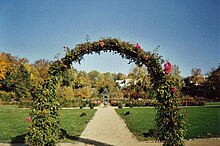Magdalenengarten
The Magdalenengarten in Hildesheim , a baroque garden, is one of the oldest historical parks in Lower Saxony.
location
The Magdalenengarten is located in the center of Hildesheim, immediately west of the well-preserved medieval city wall, not far from the Magdalenenkirche . The Magdalenengarten is bounded to the north and west by the Hohen Wall , and to the south by the Magdalenenhof nursing home . The entrance to the park is accessible to everyone via the property of the retirement home. From the “Museum” stop on city bus routes 1, 4 and 5, the Magdalenengarten can be reached via Burgstrasse and Wohl after a ten-minute walk.
history

In Hildesheim a monastery of the penitent sisters of St. Magdalenen was founded outside the city walls in 1224 , the only nunnery of the Middle Ages in Hildesheim. The oldest documented mention comes from 1235. The nuns lived according to the Augustine Rule and were popularly called Süstern , which is still reminiscent of Süsternstrasse not far from the Magdalenengarten. The abbot of the nearby Michaelis monastery gave the nuns a piece of land in the immediate vicinity of their monastery. The orchard and vegetable garden of the Magdalenenkloster was laid out in the 13th century on this property, which lay below the vineyard of the Michaelis monastery between the city wall and the Innerste . 1720–1725 it was redesigned as a baroque ornament garden.
In the course of secularization , the monastery was dissolved in 1810 and converted into a sanatorium and nursing home in 1827 . A high wall was built on the Hohen Wall in 1827 to hide the patients in the garden from the view of the walkers on the ramparts. Until the Second World War , the former monastery garden was used to relax patients and was not open to the public. On March 22, 1945, the former monastery buildings and the Magdalenenkirche were destroyed by bombs and the garden was badly devastated. After the reconstruction, the old people's home, which still exists today, was set up here in 1952 and used the garden for the residents.
According to plans from the Baroque period , the Magdalenengarten was opened in 2003 under the direction of the landscape architect Dr. Hans-Joachim Tute redesigned in the style of the early 18th century. The original course of the paths at the time of the Baroque was still recognizable after the sward had been removed. In summer 2004, the Magdalenengarten was inaugurated in its original form as a baroque garden.
investment
The main part of the Magdalenengarten consists of eight squares, four of which form a rosarium with over 1,500 roses. In the middle of the rosarium there is a pavilion with climbing roses. Scented roses have been planted in another square, and a herb garden is in another. A 110 m long, central main path runs from the entrance to the garden in a north-south direction, which was already marked on maps from the 18th century. It ends at a statue of the Virgin Mary from 1959, behind which a meadow of orchards extends. It is followed by a small slope on which wine was grown in the Middle Ages and which has been used as a vineyard again since 1995. Above the vineyard there is a beautiful view from the vineyard pavilion.
A wall made of natural stone, built in 1827, rises to the west of the Magdalenengarten, to the east of it a well-preserved section of Hildesheim's medieval city wall extends over several hundred meters. In the northeast of the Magdalenengarten there is a beautiful panoramic view from the "Alte Bastion " vantage point , which could actually be the remains of a medieval bastion. The easily recognizable remains of a tower of the city wall have also been preserved near the vineyard.
A baroque statue of the Roman goddess Ceres was placed on a pedestal at the western edge of the rosarium . From here, a staircase leads to the so-called "Michaelisblick", a vantage point that offers a good overview of the entire Magdalenengarten and an impressive view of the Michaeliskirche. Several magnolias have been planted east of the rosarium , and there is also a pavilion here.
particularities
In addition to over 1,500 roses, there are over 100 different tree and shrub species in the Magdalenengarten. In the rose museum, which was opened in 2007 and is attached to the Magdalenengarten, you can a. inform about the cultural history of the rose.
The wild tulips ( Tulipa sylvestris ) that bloom in the west of the Magdalenengarten in April are a botanical rarity . This protected plant originally comes from the Mediterranean region and came to Germany as an ornamental plant in the 16th century. It overranced from some gardens and can still be found today in some old ramparts and parks. In Hildesheim it occurs in the Kehrwiederwall as well as in the Magdalenengarten. It may be a relic of the baroque planting.
A special attraction in the northern part of the Magdalenengarten is the small vineyard, which was planted with 198 vines of the "Müller-Thurgau" variety in 1995 and which produced the first yield three years later.
On the western edge of the orchard meadow, an " insect hotel " was built - a device that is supposed to make nesting and wintering easier for various insects.
The baroque statue of the goddess Ceres with a putto holding ears of corn in her hand was made around 1720 and set up in 2005 in the west of the Magdalenengarten. Their origin is unclear. Since 1945 it has been kept in the stone collection of the Roemer and Pelizaeus Museum , which was dissolved in 1998.
sightseeing
The Magdalenengarten can be visited daily from 9 a.m. to 6 p.m., in summer until 8 p.m. Entry is free.
Web links
Coordinates: 52 ° 9 '8.6 " N , 9 ° 56" 28.3 " E










